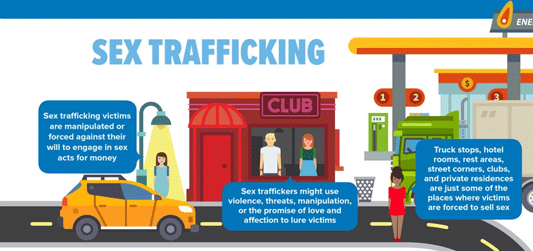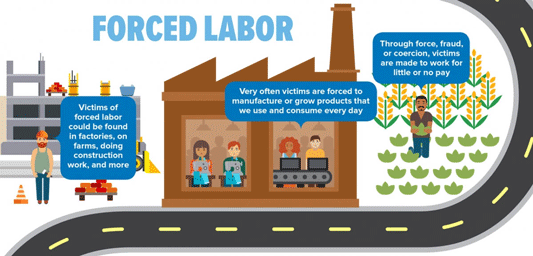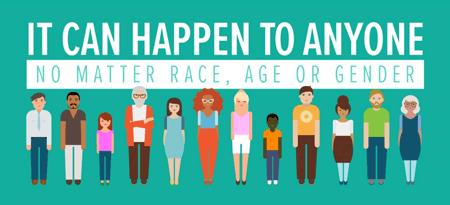In an effort to integrate human trafficking elements into Pennsylvania’s child abuse law, the General Assembly now recognizes human trafficking as a form of child abuse and neglect.
Act 115 of 2016 added “engaging a child in a severe form of trafficking in persons or sex trafficking” as part of the definition of child abuse. This includes both sex trafficking and labor trafficking of children.
Act 115 of 2016:
- Adds a category of child abuse to include:
- Engaging a child in a severe form of trafficking in persons or sex trafficking, as those terms are defined under section 103 of the Trafficking Victims Protection Act of 2000.
- Adds a category of perpetrator to include:
- an individual 18 years of age or older who engages a child in severe forms of trafficking in persons or sex trafficking, as those terms are defined under section 103 of the Trafficking Victims Protection Act of 2000.
- Provides for additional grounds for involuntary termination of parental rights.
- Provides for additional grounds for aggravated circumstances.
- Allows for release of information in confidential reports to law enforcement when investigating cases of severe forms of trafficking in persons of sex trafficking.
7.1 What is Human Trafficking?
The scale of human trafficking is atrocious. The silence that conceals this crime is disgraceful. We have to speak out because the victims are living in fear for their lives. We have to raise our voices for them. That means confronting the social and economic conditions that abet this crime. It means arresting the traffickers. And above all, it means protecting the victims.
Former United Nations Secretary General Ban Ki-moon
Human trafficking is the recruitment, harboring, transportation, provision or obtaining of a child or adult for sex, labor, or services through the use of force, fraud, or coercion. It is a widespread problem, affecting tens of millions of people worldwide. As with many other countries, the United States is both a source and a destination for U.S. citizens and foreign nationals who are subjected to sex trafficking and forced labor (Hemmings et al., 2016).
Adults and children are exploited in both legal and illegal industries, including in commercial sex, hospitality, traveling sales crews, agriculture, seafood, manufacturing, janitorial services, construction, restaurants, healthcare, care for persons with disabilities, salon services, fairs and carnivals, peddling and begging, drug smuggling and distribution, childcare, and domestic work. In addition, forced labor occurs in sectors such as legal and illegal mining, emerald extraction, coal, domestic service, agriculture near the coffee belt, cattle herding, and crop harvesting.
Healthcare providers can come into contact with individuals being trafficked, usually in the emergency department. Identifying signs of trauma, recognizing verbal and nonverbal cues, assessing a victim’s response, and referring to appropriate team members are key components of effective trauma-informed care. Missed opportunities to identify, inform, and empower victims perpetuates this physically and psychologically debilitating practice (Toney-Butler et al., 2023).
In Pennsylvania in 2021, the National Human Trafficking Hotline received 596 phone calls, 153 emails, and 64 online tip reports related to human trafficking in the state. These calls resulted in 153 reports of human trafficking, of which 85% were related to sex trafficking, and 10% for labor trafficking. About a quarter of the reported cases involved minors (NHTH, 2023).
7.1.1 Severe Forms of Human Trafficking
Severe forms of human trafficking in persons include:
Sex trafficking in which a commercial sex act is induced by force, fraud, or coercion or in which the person induced to perform such act has not attained 18 years of age; or
- Sex trafficking: the recruitment, harboring, transportation, provision, obtaining, patronizing, or soliciting of a person for the purpose of a commercial sex act*.
*Commercial sex act: any sex act on account of which anything of value is given to or received by any person. - The recruitment, harboring, transportation, provision, or obtaining of a person for labor or services, through the use of force, fraud, or coercion, for the purpose of subjection to involuntary servitude, peonage, debt bondage, or slavery.
Any child under the age of 18 who is manipulated or forced to engage in sex acts for money (or for anything of value) is a victim of sex trafficking. Severe forms of human trafficking include sex trafficking in which a commercial sex act is induced by force, fraud, or coercion, or in which the person induced to perform such act has not attained 18 years of age.
The use of children in commercial sex is prohibited under U.S. law and by statute in most countries. Sex trafficking has devastating effects on children, causing long-lasting physical and psychological trauma, disease (including HIV/AIDS), drug addiction, unwanted pregnancy, malnutrition, social ostracism, and even death (USDOS, 2022).
When a child under 18 years of age is recruited, enticed, harbored, transported, provided, obtained, patronized, solicited, or maintained to perform a commercial sex act—proving force, fraud, or coercion is not necessary for the offense to be prosecuted as human trafficking. There are no exceptions: no cultural or socioeconomic rationalizations alter the fact that children who are exploited in prostitution are trafficking victims (USDOS, 2022).

Source: Department of Homeland Security.
Labor trafficking: Labor obtained by use of threat of serious harm, physical restraint, or abuse of legal process.
Labor trafficking is labor obtained by use of threat of serious harm, physical restraint, or abuse of legal process. It includes the use of force, fraud, or coercion to recruit, harbor, transport, or obtaining a person for the purpose of subjection in involuntary servitude, peonage1, debt bondage2, or slavery3.
1Peonage: paying off debt through work.
2Debt bondage: debt slavery, bonded labor, or services for a debt or other obligation.
3Slavery: a condition compared to that of a slave in respect of exhausting labor or restricted freedom.
The term “forced child labor” describes schemes in which traffickers compel children to work. Traffickers often target children because they are more vulnerable. Although some children may legally engage in certain forms of work, forcing or coercing children to work remains illegal (USDOS, 2022).
Forms of slavery or slavery-like practices—including the sale of children, forced or compulsory child labor, debt bondage, and serfdom of children—continue to exist, despite legal prohibitions and widespread condemnation. Some indicators of forced labor of a child include situations in which the child appears to be in the custody of a non-family member and the child’s work financially benefits someone outside the child’s family; or the denial of food, rest, or schooling to a child who is working (USDOS, 2022).
Labor trafficking includes agricultural, factory, and domestic service workers who are underpaid or not paid at all, physically abusive traveling sales crews that force children to beg, sell legal items, or illegal items. It also includes workers in restaurants, hair, and nail salons who are abused, confined, or not paid.
Examples:
- Being forced to work for little or no pay (frequently in factories and farms).
- Domestic servitude: providing services within a household for 10-16 hours per day, such as, but not limited to: childcare, cooking, cleaning, yard work, gardening, etc.

Source: Department of Homeland Security (public domain).
7.2 Who Are the Victims?
Victims of human trafficking come from almost every region of the world. The top three countries of origin of federally identified victims in fiscal year 2016 were the United States, Mexico, and the Philippines (USDOS, 2022).
Populations at particular risk for victimization in the United States include children in the child welfare, foster care, or juvenile justice systems. Runaway and homeless youth and unaccompanied children are particularly vulnerable. Migrant laborers, undocumented workers, temporary workers, and foreign nationals working in diplomatic households can also be victims of human trafficking.
Other potential victims include at-risk youth populations—including, but not limited to, youth:
- In the foster care system
- Who identify as LGBTQ+
- Who are homeless or a runaway
- With disabilities
- With a history of sexual abuse
- With mental health and/or substance abuse disorders
- With a history of being involved in the welfare system
- Who identify as native or aboriginal
- With family dysfunction
Individuals with certain histories—such as sexual abuse, violence, substance abuse, family dysfunction, or untreated mental health disorders—are considered at increased risk for human trafficking. Adults and children who enter the U.S. with or without legal status have been identified as trafficking victims. There is ongoing concern about the risk of human trafficking in global supply chains, including in federal contracts (USDOS, 2022).

Source: Department of Homeland Security (public domain).
7.3 Recognizing Warning Signs
Signs of possible child trafficking include unexplained absences, poor attendance, runaway behavior, or boasting about frequent travel to other cities. Inappropriate dress for the current weather, being sleep-deprived or malnourished, or impairment due to drugs or alcohol can be additional indicators (Toney-Butler et al., 2023).
Traffickers may “hospital shop” for quicker wait times. An accompanying “family member” that is impatient, in your face, or upset over lengthy delays may be a trafficker. Another indicator is the “spouse” or “boyfriend” that insists that a high-risk patient, such as one with a possible ectopic pregnancy or appendicitis, leave without being seen, against medical advice, or before care is completed (Toney-Butler et al., 2023).
A trafficked child or youth may be hyper-vigilant, paranoid, keep unusually late hours, or may be secretive about their living situation. A child may lie about—or be unaware—of his or her true age, have no knowledge of personal data, such as date of birth, or have no identification.
A child or young adult being trafficked for sex may have a prior arrest record for prostitution or related charges or have multiple sexually transmitted diseases or pregnancies. Maintaining an explicitly sexual online profile, frequenting internet chat rooms or classified sites, wearing sexually provocative clothing, or depicting sexual exploitation in drawing, poetry, or other modes of creative expression are red flags.
Victim identification/warning signs include, but are not limited to:
- Has been verified to be under the age of 18 and is in any way involved in a commercial sex act industry or has a record of prior arrest for prostitution or related charges.
- Has an explicitly sexual online profile.
- Excessively frequents internet chat rooms and classified sites.
- Depicts elements of sexual exploitation in drawing, poetry, or other modes of creative expression.
- Secrecy about whereabouts.
- Has late nights or unusual hours.
- Is found in a hotel, street track, truck stop, or strip club.
- Lies about or has no identification or knowledge of personal data, such as but not limited to age, name, and/or date of birth.
- Does not have insurance or control over own finances.
- Wears clothing that is dirty and inappropriate for the weather; it may be too large or too small (often dresses or skirts that are provocative in nature).
- Wears new clothes of any style and gets hair and/or nails done with no financial means.
- Has multiple cell phones or very expensive items that they have no way of purchasing on their own.
- Has unaddressed medical issues or goes to the ER or clinic alone or with an unrelated adult.
- Exhibits hypervigilance or paranoid behaviors.
- Is in a controlling or dominating relationship.
- Avoids answering questions and lets someone else speak for them.
- Expresses interest in or is in relationships with adults or much older adults.
- Has significant change in behavior, including increased social media and new associates or friends at school.
- Has frequent or multiple sexually transmitted diseases or pregnancies.
- Has unexplained injuries and/or unbelievable or inconsistent explanations of injuries.
- Has multiple bruises or cuts in various stages of healing.
- Has a tattoo they’re reluctant to explain.
- Uses specific terms such as “trick”, “the life”, or “the game”.
7.4 Healthcare Provider Responsibilities
Healthcare providers are one of the few professionals who are likely to interact with victims of human trafficking. Multiple studies have found that up to 88% of victims came into contact with the healthcare system while being trafficked. About two-thirds of victims seek medical care from emergency departments, about 30% from Planned Parenthood clinics, and about 20% from private practices, urgent care clinics, women’s health clinics, and neighborhood clinics (McAmis et al., 2022).
Because of the exploitation and abuse associated with human trafficking, individuals suffer physical, psychological, sexual, and reproductive health problems. Responding to the needs of a person being trafficked requires trauma-informed and culturally sensitive care. Identifying signs of trauma, recognizing verbal and nonverbal cues, assessing a victim’s response, and referring to appropriate team members are key components of effective trauma-informed care. Missed opportunities to identify, inform, and empower these victims perpetuate this physically and psychologically debilitating practice (Toney-Butler et al., 2023).
Common concerns that prompt contact with the healthcare system include infectious diseases, trauma or injury from physical violence, sexual abuse, malnutrition, dental disease, posttraumatic stress disorder, anxiety, depression, or substance use disorders. In many cases, these symptoms are vague and not necessarily directly related to the trafficking experience but are related to the lifestyle they have been forced to practice (McAmis et al., 2022).
For victims of child trafficking in controlling of dominating relationships with an older adult, entering the healthcare system presents an opportunity for discovery. Traffickers may only seek care for their victims when a victim becomes seriously ill. They often seek out the quickest means of care, and lengthy emergency department waits may cause them to leave with the victim before receiving medical treatment (Toney-Butler et al., 2023).
There was often a delay between the onset of an injury or illness and the victim’s interaction with a healthcare provider. Contact with a healthcare providers may be the only time a victim can engage in a one-on-one discussion with a trusted professional. Providers can offer medical and psychological care for these victims as they suffer from a wide range of health risks due to their circumstances and experiences (McAmis et al., 2022).
Providing support and services should focus on four main needs: (1) immediate medical need, (2) mental health assistance, (3) income support, and (4) legal status for international victims. Unfortunately, many victims may not be recognized due to lack of knowledge by healthcare providers, the control of the victim’s visit by a trafficker, the fear or shame the victim may experience, or social or cultural alienation (McAmis et al., 2022).
